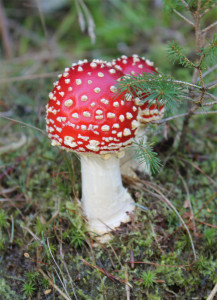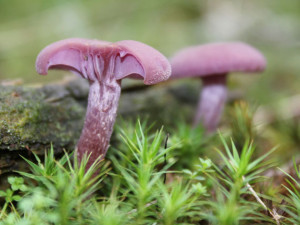Understanding how plants and fungi developed symbiotic relationships.
With apologies to the poet John Donne, and based on recent work from the U.S. Department of Energy Joint Genome Institute (DOE JGI), a DOE Office of Science user facility, it can be said that no plant is an island, entire of itself. Unseen by the human eye, plants interact with many species of fungi and other microbes in the surrounding environment, and these exchanges can impact the plant’s health and tolerance to stressors such as drought or disease, as well as the global carbon cycle.

Mycorrhizal fungi include some of the most conspicuous forest mushrooms, such as the iconic fly agaric (Amanita muscaria), of the fungi sequenced for this project. (Francis Martin, INRA)
Mycorrhizal fungi live in the roots of host plants, where they exchange sugars that plants produce by photosynthesis for mineral nutrients that fungi absorb from the soil. They include some of the most conspicuous forest mushrooms, including the iconic, flaming red “fly agaric,” Amanita muscaria, and are of interest to bioenergy researchers, because they play roles in maintaining the health of candidate feedstock crop trees. Recent studies indicate that mycorrhizal fungi also play a significant role in belowground carbon sequestration, which may mitigate the effects of anthropogenic CO2 emissions.
To understand the basis for fungal symbiotic relationships with plants, a team of DOE JGI researchers led by Igor Grigoriev and longtime collaborators at the French National Institute for Agricultural Research (INRA) and Clark University conducted the first broad, comparative phylogenomic analysis of mycorrhizal fungi, drawing on 49 fungal genomes, 18 of which were sequenced for this study. The 18 new fungal sequences included 13 mycorrhizal genomes, from ectomycorrhizal fungi that penetrate the host roots, and including species that comingle with orchid and heathland (which include blueberry, heather, and heath) plant roots. Published ahead online February 23, 2015 in Nature Genetics, these researchers describe how the comparative analyses of these genomes allowed them to track the evolution of mycorrhizal fungi. The results help researchers understand how plants and fungi developed symbiotic relationships, and how the mutualistic association provides host plants with beneficial traits for environmental adaptation.
Starting with previously sequenced mycorrhizal fungi
“Mycorrhizal symbioses are highly complex, but analyses of the 49 genomes indicate that they have evolved independently in many fungal lineages,” said INRA’s Francis Martin, one of the study’s senior authors. To understand the genetic shifts underlying the repeated origins of mycorrhizal lifestyles, the researchers focused on enzymes that degrade plant cell walls from 16 gene families associated with plant cell wall degradation. They took their cue from the first sequenced ectomycorrhizal fungus, Laccaria bicolor and the first sequenced arbuscular mycorrhizal fungus Rhizophagus irregularis– all work done at the DOE JGI–which illuminates the origins and evolution of these enzymes, knowledge to be applied in collaboration for improving biomass breakdown for biofuels production.
Through molecular clock analyses, which combine genome-scale molecular data with fossil calibrations, the team could work backwards to estimate when saprotrophic and mutualistic lineages last shared common ancestors based on the amount of divergence.
The analyses of the fungal genomes and fossils suggested that in comparison to brown rot fungi and white rot fungi that evolved over 300 million years ago, ectomycorrhizal fungi emerged fairly recently from several species and then spread out across lineages less than 200 million years ago. The team also found that up to 40 percent of the symbiosis-induced genes were restricted to a single mycorrhizal species.
Fungi evolving to break down plant cell walls

The amethyst deceiver or L. amethystina was another of the 49 fungi whose genome sequences were used for this broad comparative analysis. (Francis Martin, INRA)
David Hibbett of Clark University, another of the study’s senior authors, compared the work to a previous collaboration with the DOE JGI detailed in Science to trace the evolution of white rot fungi, which are capable of breaking down cellulose, hemicellulose and lignin in plants. Prior to the emergence of white rot fungi hundreds of millions of years ago, fungi were not capable of breaking down lignin, and the undecayed plant mass became the basis of large coal deposits.
“Together these studies tell a story about how mushroom-forming fungi evolved a complex mechanism for breakdown of plant cell walls in ‘white rot’ and then cast it aside following the evolution of mycorrhizal associations, as well as the alternative decay mechanism of ‘brown rot,’” Hibbett said. “The other major part of the story is that in mycorrhizal lineages there is a huge turnover in genes that are upregulated in the symbiosis-many of these have no homologs in even closely related species, suggesting that the evolution of the symbiosis is associated with massive genetic innovation.”
Martin chimed in: “Many of these genes are likely used to control plant immunity during the massive colonization of root tissues by the fungus.”
DOE JGI’s Igor Grigoriev also pointed out, “This first large-scale study of mycorrhizal genomics is also the first step in both broader and deeper exploration of mycorrhizal diversity, their interactions with host plans, and roles in forest ecosystems using genomics tools, which are the focus areas for the JGI Fungal Genomics Program.”
Martin, leader of the Mycorrhizal Genomics Initiative, a DOE JGI Community Science Program project, is presenting on “Harnessing Genomics for Understanding Tree-Microbe Interactions in Forest Ecosystems” at the 10th Annual Genomics of Energy & Environment Meeting, set for March 23-26, 2015 in Walnut Creek, California. To register for the meeting, and to see the rest of the agenda, go to http://usermeeting.jgi.doe.gov. Annegret Kohler, the first author on the Nature Genetics paper, will present on aspects of this work at the fungal workshop that precedes the meeting: http://usermeeting.jgi.doe.gov/2015-workshops/.
For those interested in exploring new project submissions, the 2016 Community Science Program call for letters of intent deadline is April 16, 2015. More information can be found at http://bit.ly/JGI-2016-CSP.